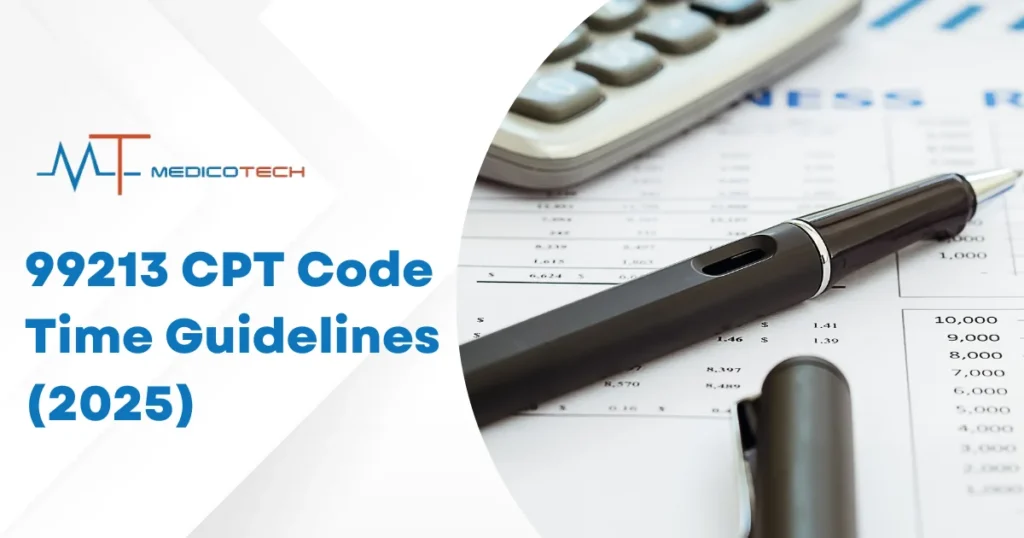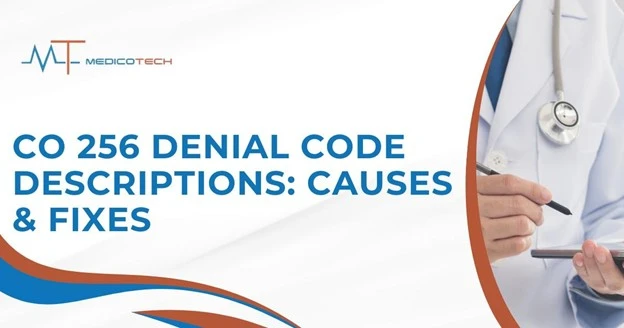Healthcare providers must use CPT (Current Procedural Terminology) codes to manage patient service reports properly while ensuring appropriate payment for healthcare services. The office or outpatient visits most commonly employ CPT Code 99213 as their primary billing code. This article provides a complete explanation of CPT Code 99213 by describing its specifications, usage criteria, billing procedures, and compliance requirements for medical services.
What Is CPT Code 99213?
This Evaluation and Management service code 99213 exists within the CPT category intended for established patient treatments at outpatient facilities. The code represents medical care at a balanced service intensity designed for treating patients with controlled conditions who need periodic check-ups and administrative procedures.
The CPT code serves healthcare providers to bill for consultations, follow-ups, and minimal evaluations that last from 20 to 29 minutes. The successful billing process under this code demands detailed rules to be followed strictly because it determines both documentation quality and reimbursement success.
When to Use CPT Code 99213
A healthcare provider should select CPT Code 99213 for the following criteria:
- Patients who repeatedly visit their healthcare professional are considered established due to earlier health visits.
- The provider dedicates their time within 20 to 29 minutes of face-to-face interactions for history-taking, examination activities, and medical decision-making.
- The complexity level for medical decision-making falls under the moderate category (we will discuss this point further below).
- The procedure entails continuing care for stable health conditions instead of handling new serious medical diagnoses.
- The professionals select CPT Code 99213 only for established patient visits because new patient services need higher codes, and highly complex or easy cases do not match this code. Auditing of medical records will help determine the appropriate use of this code.
Providers should note that CPT Code 99213 is not applicable for new patient services. New patient codes, such as CPT Code 99204, are more suitable for complex cases involving first time visits.
Duration of CPT Code 99213
The duration of CPT Code 99213 spans from 20 to 29 minutes. The duration of patient care sessions determines the billing process for CPT Code 99213. CMS specifies that health professionals should use this code for patient visits between 20 to 29 minutes in duration. The functional reimbursement period needs to combine actual patient interaction with essential task completion, which involves record review along with care coordination endeavors.
The time requirement remains critical for 99213, but alone cannot establish its appropriate use. The documentation requirements for history, examination, and MDM (Medical Decision-Making) must also be met to justify using CPT 99213.
Documentation Guidelines for CPT 99213
Doctors must establish proper documentation as the main requirement for CPT Code 99213 usage. Here are some essential guidelines:
- The medical documentation should include a review of existing patient medical records together with essential family history and social background information. The main components of documentation need to start with a defined chief complaint followed by the history of present illness and a review of systems assessment.
- Documentation of performed physical examination remains an essential requirement for the provider. The specific type and intensity of examination will differ based on the patient’s medical situation but must fulfill the mandatory criteria for specific testing.
- The MDM part of 99213 requires a moderate complexity level that entails a moderate quantity of diagnoses and options in addition to moderate patient health risks.
History Component Needed for 99213
The historical elements of CPT Code 99213 need to include concentrated assessment activities. It typically includes:
- The main motive for patient attendance is known as the chief complaint (CC).
- The present illness history describes the symptoms along with their length of persistence.
- During the review of systems, the practitioner assesses just a few systems.
Exam Requirements for CPT 99213
The required assessment component for CPT 99213 must be direct instead of extensive. The documentation requirement for a comprehensive examination does not exist, yet the provider must record pertinent findings that connect to the purpose of the visit. For example:
- The healthcare provider must inspect the targeted regions that display signs or symptoms.
- The physician records all physical exam-identified signs together with symptoms.
Medical Decision Making (MDM) Level Required
A moderate complexity level applies to MDM evaluation in the case of CPT Code 99213. This means:
- Two conditions determine the MDM level: the provider must examine at least one diagnosis or treatment option while working with multiple possible diagnoses.
- A moderate amount of data requirements exist for the purpose of evaluation (such as lab test data).
- The potential patient risks fall under the moderate category (which includes treatment modifications together with complications).
99213 vs. 99214: Key Differences
The primary subject of inquiry regarding the difference between CPT Code 99213 and CPT Code 99214 exists among practitioners in medical billing and coding. These two codes differ based on how long the physician interacts with the patient and what level of medical decisions are made using variable assessment complexity levels.
The healthcare provider applies 99213 to visit patients with moderate complexity needs, whereas 99214 addresses patients requiring advanced medical decision-making during complex visits.
The requirements for CPT Code 99214 include 25 minutes of direct patient contact, then proceed with a detailed combination of history-taking along with comprehensive examination and medical decision-making procedures.
The medical decision-making components and longer patient appointment duration qualify cases for billing 99214 instead of 99213.
How to Bill CPT Code 99213 Correctly (2025 Updates)
When performing appropriate CPT Code 99213 billing, you should follow this process:
- The 99213 code applies to patients already known to your practice.
- Use appropriate time tracking to document 20 to 29 minutes of care, which combines actual patient time spent with documentation and other administrative tasks.
- A proper visit assessment must maintain challenging levels of complexity throughout all three categories: history, examination, and medical decision-making.
- Bills must contain proper modifiers whenever applicable, especially for telehealth visits along with other specified conditions.
Medicare & Private Payer Rules
Private insurance organizations, together with Medicare, operate under somewhat altered rules for billing CPT Code 99213. For instance:
- Medicare implements strict documentation and diagnosis requirements for its program.
- Different insurance firms operate under individual instructions, and they might impose authorization requirements before paying for particular services.
- Keeping current with payer requirements remains vital because failing to do so can lead to payment issues.
Reizbursement Rates for 99213
The reimbursement amount for CPT Code 99213 depends on the doctor’s practice location, medical insurance company, and additional determining criteria. Typically, reimbursement is based on:
- Every geographical area maintains its own reimbursement rates because they consider the costs within each region.
- The reimbursement rates from private insurance companies differ significantly from one insurer to another.
- The reimbursement amount tends to increase when healthcare providers extend their service to include diagnostic testing during office appointments.
- Protocols for reimbursement verification should be followed through either CMS (Centers for Medicare & Medicaid Services) or your private insurer fee schedules.
Common Billing Mistakes & How to Avoid Them
Several errors occur when practitioners bill CPT Code 99213:
- Only bill 99213 for established patients since using it improperly on new patients leads to incorrect billing.
- The time documentation should show both patient-clinician face-to-face contact together with any needed documentation and coordination work.
- To achieve proper documentation, all essential parts, such as history, exam, and medical decision-making, must be completely recorded.
- Accurate documentation combined with updated coding guidelines acts as prevention against coding errors, and regular checks through accurate time recording should be maintained.
FAQs About CPT Code 99213
What is the medical decision-making process requirement for MDM in moderate complexity parameters?
The medical decision-making requirements needed for a visit classify it at the “moderate complexity” level. The provider assesses patients with stable, complicated medical situations while examining moderate patient files but handles moderate patient risks.
Is it possible to charge for 99213 services when the patient appointment lasts shorter than 20 minutes?
The 99213 CPT code serves visits that extend from 20 through 29 minutes. A different CPT code needs to be considered when the visit duration falls shorter than the specified limit.
Can I use CPT Code 99213 for billing after the initial patient encounter?
The CPT code 99213 requires patient status as established, so this code cannot be used for new patients. The treatment of new patients requires selecting from codes 99201 to 99205 based on the visit complexity.
Conclusion
Medical professionals must use CPT Code 99213 whenever they bill the healthcare sector for outpatient office care with pre-existing patients. Healthcare providers who understand the documentation needs, time constraints, and distinctive features of CPT 99214 can successfully bill according to current guidelines. Useful knowledge about insurance-specific rules, along with details about documentation and frequent billing mistakes, will optimize your practice’s revenue cycle management and lower audit and payment delay risks.



 7901 4TH ST N STE 300 St. Petersburg, FL 33702
7901 4TH ST N STE 300 St. Petersburg, FL 33702


